Developer Guide
- Acknowledgements
- Setting up, getting started
- Design
- Implementation
- Documentation, logging, testing, configuration, dev-ops
- Appendix: Requirements
-
Appendix: Instructions for manual testing
- Launch and shutdown
- Viewing Help
- Listing all employees and projects
- Clearing all entries
- Adding an employee
- Editing an employee
- Deleting an employee
- Listing all employees
- Locate employees by name
- Adding a new project
- Editing a project
- Deleting a project
- Marking project(s) as completed
- Marking project(s) as incomplete
- Editing deadline of project(s)
- Prioritising projects
- Listing all projects
- Locating projects by name
- Adding a new task to a project
- Deleting a task from a project
- Marking task(s) as complete
- Marking task(s) as incomplete
- Sort tasks
- Assign employee(s) to a project
- Un-assign employee(s) from a project
- Assign an employee to a task
- Un-assign an employee from a task
- Saving data
- Appendix: Planned Enhancements
- Appendix: Effort
Acknowledgements
- The command parameter tables in our User Guide was inspired by a similar table from a different team W08-1, who is also taking this module presently, although our content is very different due to the different nature of our products.
Setting up, getting started
Refer to the guide Setting up and getting started.
Design
.puml files used to create diagrams in this document docs/diagrams folder. Refer to the PlantUML Tutorial at se-edu/guides to learn how to create and edit diagrams.
Architecture
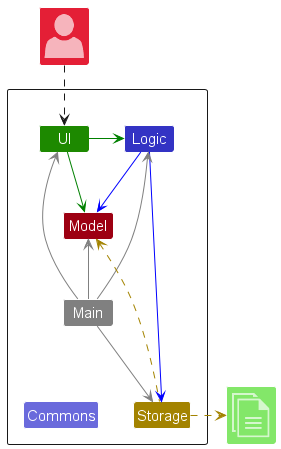
The Architecture Diagram given above explains the high-level design of the App.
Given below is a quick overview of main components and how they interact with each other.
Main components of the architecture
Main (consisting of classes Main and MainApp) is in charge of the app launch and shut down.
- At app launch, it initializes the other components in the correct sequence, and connects them up with each other.
- At shut down, it shuts down the other components and invokes cleanup methods where necessary.
The bulk of the app’s work is done by the following four components:
-
UI: The UI of the App. -
Logic: The command executor. -
Model: Holds the data of the App in memory. -
Storage: Reads data from, and writes data to, the hard disk.
Commons represents a collection of classes used by multiple other components.
How the architecture components interact with each other
The Sequence Diagram below shows how the components interact with each other for the scenario where the user issues the command deleteE 1.
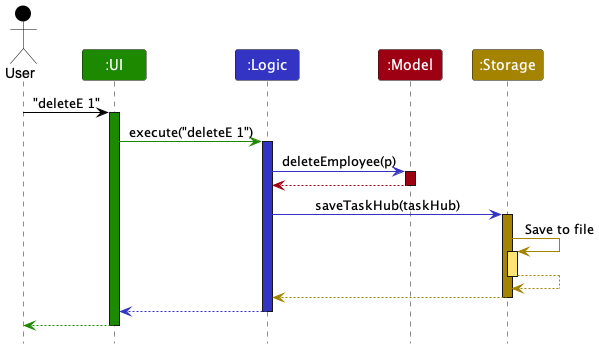
Each of the four main components (also shown in the diagram above),
- defines its API in an
interfacewith the same name as the Component. - implements its functionality using a concrete
{Component Name}Managerclass (which follows the corresponding APIinterfacementioned in the previous point).
For example, the Logic component defines its API in the Logic.java interface and implements its functionality using the LogicManager.java class which follows the Logic interface. Other components interact with a given component through its interface rather than the concrete class (reason: to prevent outside component’s being coupled to the implementation of a component), as illustrated in the (partial) class diagram below.
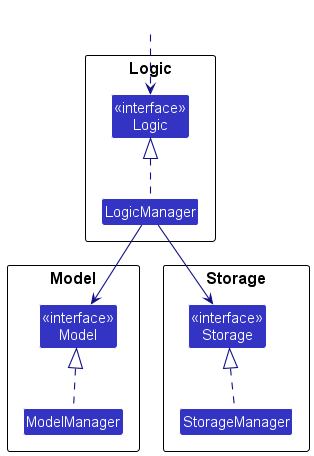
The sections below give more details of each component.
UI component
The API of this component is specified in Ui.java
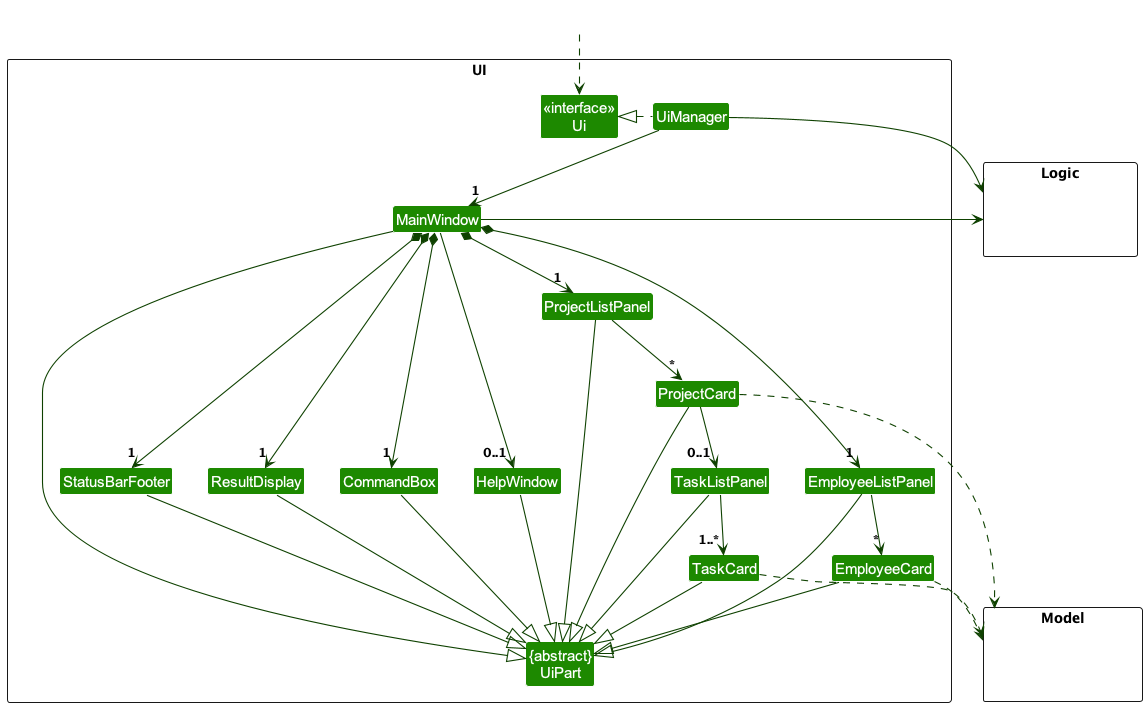
The UI consists of a MainWindow that is made up of parts e.g.CommandBox, ResultDisplay, EmployeeListPanel, ProjectListPanel, StatusBarFooter etc. All these, including the MainWindow, inherit from the abstract UiPart class which captures the commonalities between classes that represent parts of the visible GUI.
The UI component uses the JavaFx UI framework. The layout of these UI parts are defined in matching .fxml files that are in the src/main/resources/view folder. For example, the layout of the MainWindow is specified in MainWindow.fxml
The diagram above briefly demonstrates the hierarchy of the Ui components. A few more notes are as follows:
- At the level just below
MainWindow, there are the main components, likeCommandBox,ResultDisplay,EmployeeListPanelandProjectListPanel. -
EmployeeListPanelcontains some number ofEmployeeCards. -
ProjectListPanelcontains some number ofProjectCards- which contain a
TaskListPanelwith theirTaskCards if the relevantProjectin theModelcontains aTask.
- which contain a
The UI component,
- executes user commands using the
Logiccomponent. - listens for changes to
Modeldata so that the UI can be updated with the modified data. - keeps a reference to the
Logiccomponent, because theUIrelies on theLogicto execute commands. - depends on some classes in the
Modelcomponent, as it displaysEmployeeobject residing in theModel.
Logic component
API : Logic.java
Here’s a (partial) class diagram of the Logic component:
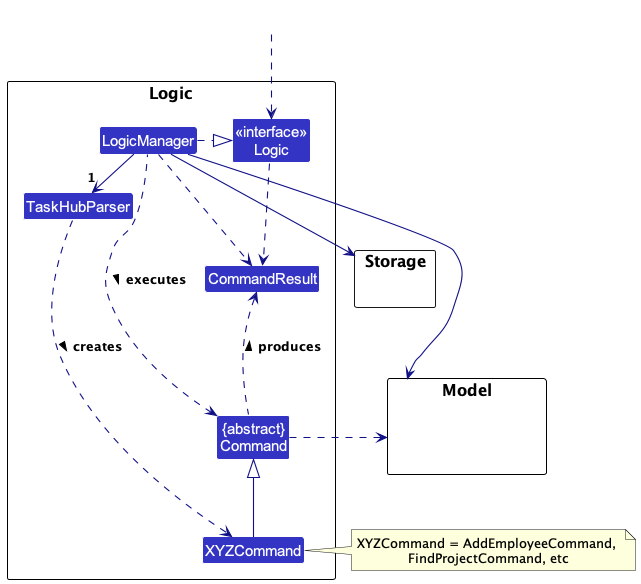
The sequence diagram below illustrates the interactions within the Logic component, taking execute("deleteE 1") API call as an example.
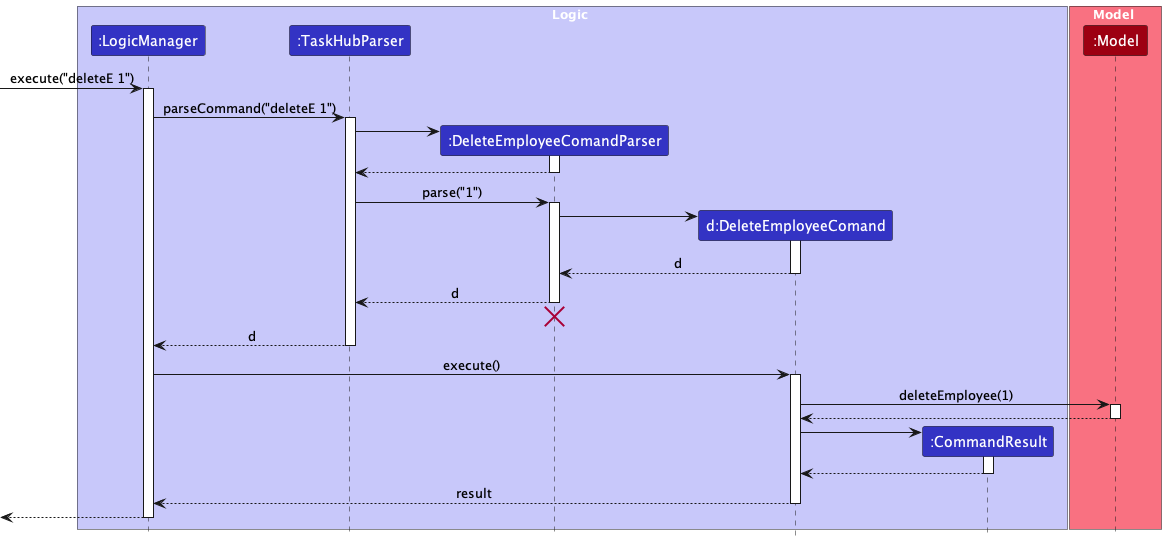
DeleteEmployeeCommandParser should end at the destroy marker (X) but due to a limitation of PlantUML, the lifeline reaches the end of diagram.
How the Logic component works:
- When
Logicis called upon to execute a command, it is passed to aTaskHubParserobject which in turn creates a parser that matches the command (e.g.,DeleteEmployeeCommandParser) and uses it to parse the command. - This results in a
Commandobject (more precisely, an object of one of its subclasses e.g.,DeleteEmployeeCommand) which is executed by theLogicManager. - The command can communicate with the
Modelwhen it is executed (e.g. to delete a employee). - The result of the command execution is encapsulated as a
CommandResultobject which is returned back fromLogic.
Here are the other classes in Logic (omitted from the class diagram above) that are used for parsing a user command:
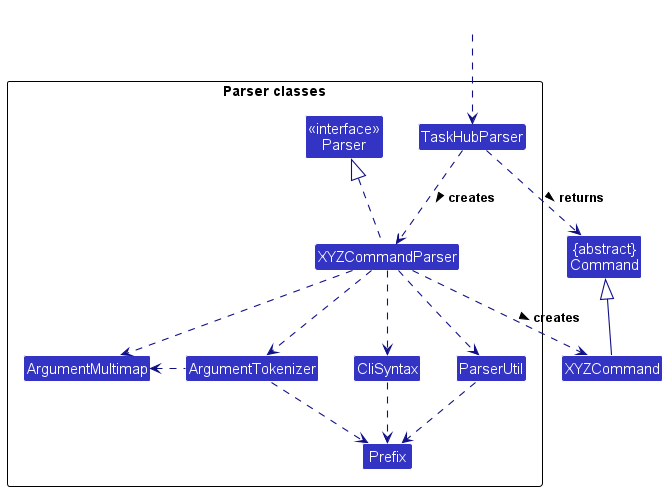
How the parsing works:
- When called upon to parse a user command, the
TaskHubParserclass creates anXYZCommandParser(XYZis a placeholder for the specific command name e.g.,AddEmployeeCommandParser) which uses the other classes shown above to parse the user command and create aXYZCommandobject (e.g.,AddEmployeeCommand) which theTaskHubParserreturns back as aCommandobject. - All
XYZCommandParserclasses (e.g.,AddEmployeeCommandParser,DeleteEmployeeCommandParser, …) inherit from theParserinterface so that they can be treated similarly where possible e.g, during testing.
Model component
API : Model.java
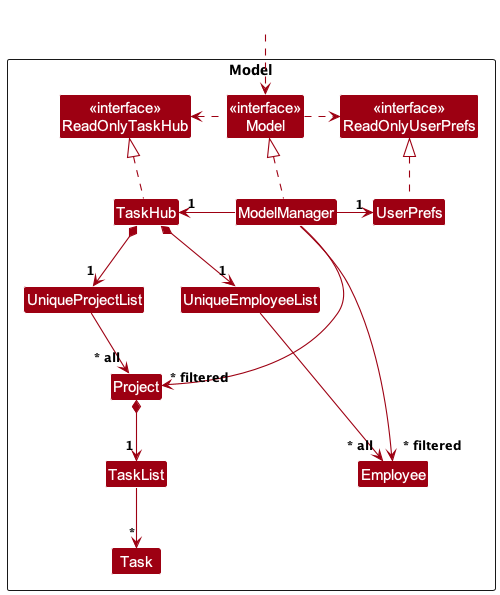
The Model component,
- stores the TaskHub data i.e., all
EmployeeandProjectobjects, which are separately contained in aUniqueEmployeeListobject and aUniqueProjectListobject.Taskobjects exist within theTaskListof aProject. - stores the currently ‘selected’
EmployeeandProjectobjects (e.g., results of a search query) as 2 separate filtered lists which are exposed to outsiders as unmodifiableObservableList<Employee>andObservableList<Project>that can be ‘observed’ e.g. the UI can be bound to this list so that the UI automatically updates when the data in the list change. - stores a
UserPrefobject that represents the user’s preferences. This is exposed to the outside as aReadOnlyUserPrefobject. - does not depend on any of the other three components (as the
Modelrepresents data entities of the domain, they should make sense on their own without depending on other components)
Employee, Project, Task classes as well as the relevant lists that contain them. More details will be provided in subsequent sections.
Employee component
API : Employee.java
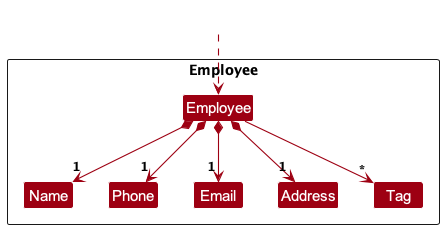
The Employee component stores an employee’s data which comprises:
- a
Name,Phone,Email,AddressandTag(s). -
Tag(s) are optional.
Project component
API : Project.java
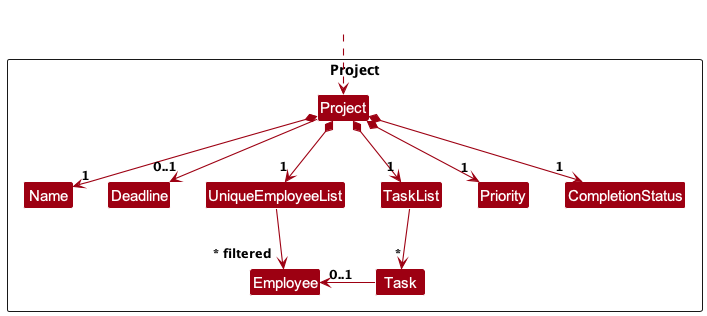
The Project component stores a project’s data which comprises:
- a
Name,Deadline,UniqueEmployeeList,TaskList,PriorityandCompletionStatus. - The
Deadlineis optional. - The
UniqueEmployeeListcontains only theEmployees under the saidProject. - Each
Employeein theUniqueEmployeeListof the project must also exist in theUniqueEmployeeListof theModel. (All fields must be the same) - The
TaskListcontains theTasks which have been added to theProject. - The
Employee(if applicable) in eachTaskin theTaskListof the project must also exist in theUniqueEmployeeListof the project.
Task component
API : Task.java
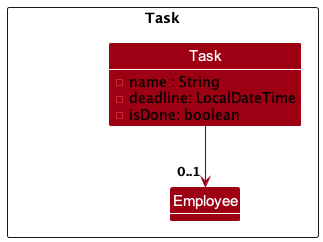
The Task component stores a task’s data which comprises:
- a
name,deadline,Employee, andisDonefield. - The
Employeeis optional - a Task may be assigned to anEmployeewithin theProjector not.
Model, Employee, Project and Task class diagrams above have omitted some details (e.g. class methods) to improve visual clarity. Only the most important fields and associations are shown.
Storage component
API : Storage.java
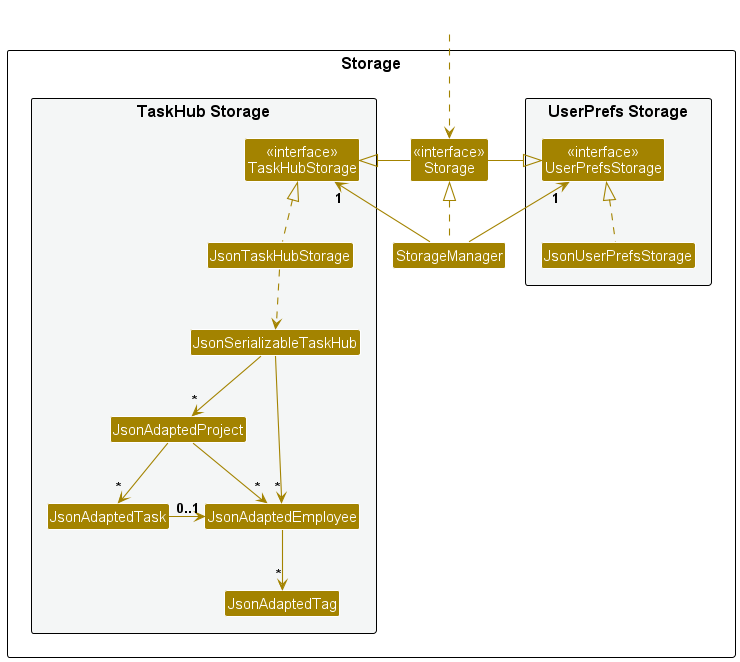
The Storage component,
- can save both TaskHub data and user preference data in JSON format, and read them back into corresponding objects.
- inherits from both
TaskHubStorageandUserPrefStorage, which means it can be treated as either one (if only the functionality of only one is needed). - depends on some classes in the
Modelcomponent (because theStoragecomponent’s job is to save/retrieve objects that belong to theModel)
Common classes
Classes used by multiple components are in the seedu.address.commons package.
Implementation
This section describes some noteworthy details on how certain features are implemented.
Upgraded Help Feature
In the initialize() method of the HelpWindow class, commands are organized into different categories using HashMaps. Here’s an explanation:
// Initializes LinkedHashMaps to store commands for different sections
Map<String, String> generalCommands = new LinkedHashMap<>();
Map<String, String> employeeCommands = new LinkedHashMap<>();
Map<String, String> projectCommands = new LinkedHashMap<>();
Map<String, String> taskCommands = new LinkedHashMap<>();
Map<String, String> assignmentCommands = new LinkedHashMap<>();
The command formats with short descriptions accompanying them are then inserted into each LinkedHashMap accordingly.
The keys in the LinkedHashMap represent the command formats, while the corresponding values provide a description of what each command does.
// Adds sections and their respective commands to the VBox layout
addToVBox("General Commands", generalCommands);
addToVBox("Employee Commands", employeeCommands);
addToVBox("Project Commands", projectCommands);
addToVBox("Task Commands", taskCommands);
addToVBox("Assignment Commands", assignmentCommands);
The addToVBox() method takes a section header (like “General Commands”) and a corresponding HashMap of commands. It then formats and adds these commands to the VBox layout of the help window.
This code structure efficiently organizes commands into distinct sections, making it easier for users to locate and understand the functionalities provided by each command. It also promotes code readability and maintainability for developers working on the application.
An alternative imeplementation of HelpWindow could be to store each command format and description in a centralized database, and retrieve the data from there to be displayed in the HelpWindow, rather than to have to modify the code in HelpWindow separately when there is a change in the formats/descriptions.
Add Project Feature
When creating a new project from the addP command, each Employee that is to be added to the Project is updated to have an empty Project. This is to avoid cyclic dependency between an Employee and a Project.
Given below is an example usage scenario and the internal changes that happen at each step.
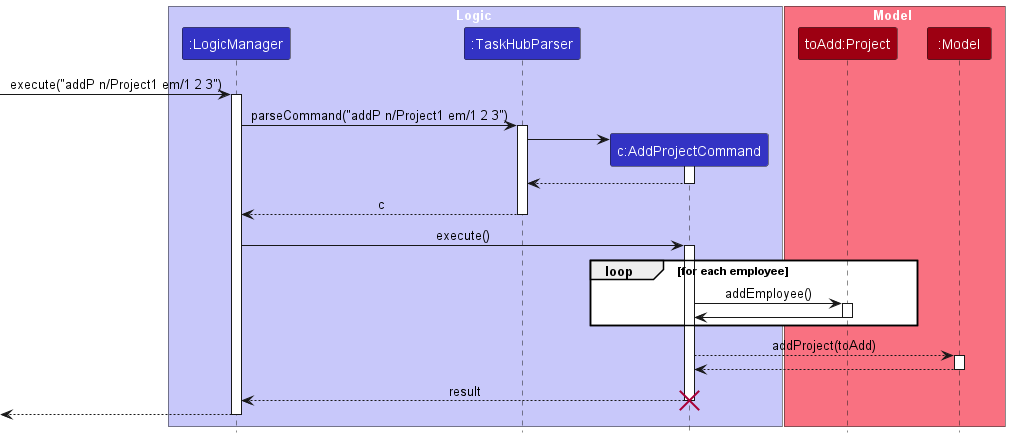
Step 1. The user launches the application. All employees and projects will be shown to the user.
Step 2. The user executes addP n/Project1 em/1 2 3 to add a new Project called Project1 with the 1st, 2nd and 3rd Employee on the list as a member. LogicManager will call TaskHubParser#parse(input) to extract the parameters and pass it to an AddProjectCommandParser.
Step 3. TaskHubParser will call AddProjectCommandParser#parse(arguments) to produce a AddProjectCommand to be executed by the LogicManager.
Step 4. LogicManager calls AddProjectCommand#execute(model) to produce a CommandResult to be logged.
Step 5. During the execution of the AddProjectCommand, selected Employees are extracted from the current UniqueEmployeeList of TaskHub and added to the Project in the AddProjectCommand. New copies of Employee objects are also created to replace the original Employee objects in the UniqueEmployeeList using a new EditCommand.
Step 6. A CommandResult is produced based on whether the execution was a success or not and returned to the LogicManager.
Prioritise Projects Feature
A priority can be assigned to multiple projects using the priorityP command.
This command modifies the Priority attribute of a Project by creating a new Project with the updated Priority and replacing the existing project with the updated one.
Given below is an example usage scenario and the internal changes that happen at each step.
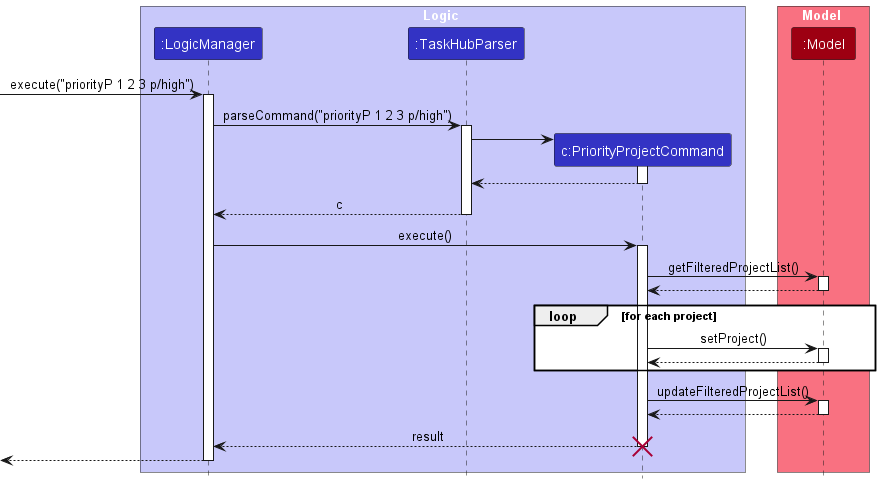
Step 1. The user launches the application. All employees and projects will be shown to the user.
Step 2. The user executes priorityP 1 2 3 p/high to assign a high priority to the projects indexed at 1, 2 and 3. LogicManager will call TaskHubParser#parse(input) to extract the parameters and pass it to a PriorityProjectCommandParser.
Step 3. TaskHubParser will call PriorityProjectCommandParser#parse(arguments) to produce a PriorityProjectCommand to be executed by the LogicManager.
Step 4. LogicManager calls PriorityProjectCommand#execute(model) to produce a CommandResult.
Step 5. During the execution of the PriorityProjectCommand, new projects are created with the same details as the projects whose Priority is supposed to be changed, except that the Priority for all the projects are now high.
Step 6. The model is updated accordingly through ModelManager by replacing the old projects with the new projects with the updated Priority.
Step 7. A CommandResult is produced based on whether the execution was a success or not and returned to the LogicManager.
Find Projects Feature
The displayed list of Projects can be filtered by name (specifically, the keywords that the project name contains).
The findP command accepts a sequence of keywords (at least 1) and filters the displayed Projects accordingly.
Once the Projects are filtered out, the displayed list of Employees will also be filtered out, according to whether
they are under at least one of the said filtered Projects.
Given below is an example usage scenario and the internal changes that happen at each step.
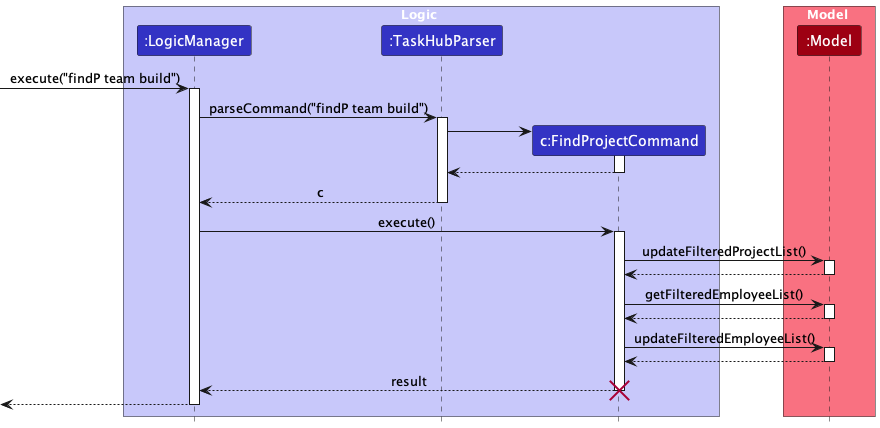
Step 1. The user launches the application. All employees and projects will be shown to the user.
Step 2. The user executes the findP website presentation command to search for projects with name containing “website” and/or “presentation”.
LogicManager will call TaskHubParser#parse(input) to extract the parameters and pass it to an FindProjectCommandParser.
Step 3. TaskHubParser will call FindProjectCommandParser#parse(arguments) to produce a FindProjectCommand to be executed by the LogicManager.
Step 4. LogicManager calls FindProjectCommand#execute(model) to produce a CommandResult.
Step 5. During the execution of the FindProjectCommand, the ProjectNameContainsKeywordsPredicate predicate that is received, is
used to update the model’s FilteredProjectList through ModelManager.
Step 6. Then, using the updated FilteredProjectList from step 5, a new EmployeeUnderFilteredProjectsPredicate predicate is created. Using this predicate,
the model’s FilteredEmployeeList is updated through ModelManager.
Step 7. A CommandResult is produced based on whether the execution was a success or not and returned to the LogicManager.
Mark Projects Feature
Execution of the markP command will result in each Project being marked as completed. This is done by setting each Project’s isCompleted attribute to true.
Given below is an example usage scenario and the internal changes that happen at each step.
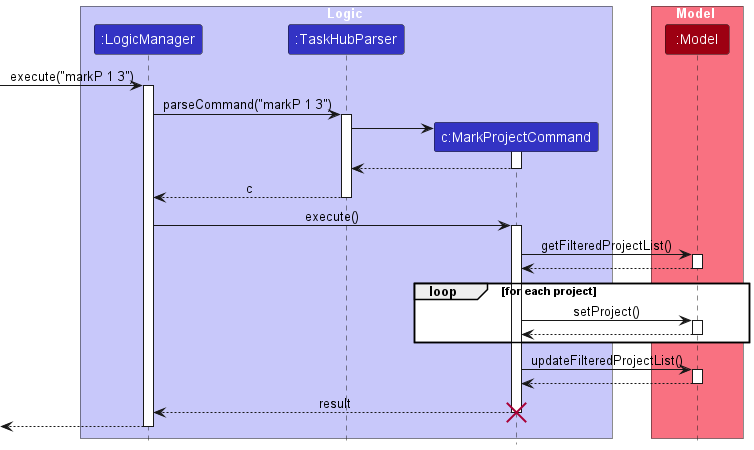
Step 1. The user launches the application. All employees and projects will be shown to the user.
Step 2. The user executes markP 1 3 to mark the 1st and 3rd Project on the shown list as completed. LogicManager will call TaskHubParser#parse(input) to extract the parameters and pass it to a MarkProjectCommandParser.
Step 3. TaskHubParser will call MarkProjectParser#parse(arguments) to produce a MarkProjectCommand to be executed by the LogicManager.
Step 4. LogicManager calls MarkProjectCommand#execute(model) to produce a CommandResult to be logged.
Step 5. During the execution of the MarkProjectCommand, a new Project object is created for each Project to be marked as completed. The new Project objects are then used to replace the original Project objects in the UniqueProjectList.
Step 6. A CommandResult is produced based on whether the execution was a success or not and returned to the LogicManager.
A similar sequence of events will occur when executing the unmarkP command, except that the isCompleted attribute of each Project will be set to false instead of true in step 5.
Set Deadline for Project Feature
The deadline of a Project can be set using the editP or the dlP commands.
The former is used when you only want to edit 1 project, while the latter is used when you want to edit the deadlines of 1 or more projects.
In this context, we shall use the dlP command to edit the deadline of 1 project for ease of explanation.
Step 1. The user launches the application. All employees and projects will be shown to the user.
Step 2. The user executes dlP 1 d/11-11-2023 to set the deadline of the 1st project to 11 November 2023. LogicManager will call TaskHubParser#parse(input) to extract the parameters and pass it to a DeadlineProjectCommandParser.
Step 3. TaskHubParser will call DeadlineProjectCommandParser#parse(arguments) to produce a DeadlineProjectCommand to be executed by the LogicManager.
Step 4. LogicManager calls DeadlineProjectCommand#execute(model) to produce a CommandResult.
Step 5. During the execution of the DeadlineProjectCommand, a new Project object is created with the same details as the project whose deadline is supposed to be changed, except that the deadline is now 11 November 2023.
Step 6. The model is updated accordingly through ModelManager by replacing the old project with the new project with the updated deadline.
The following activity diagram summarises the steps taken to set the deadline of a project, from the user’s perspective:
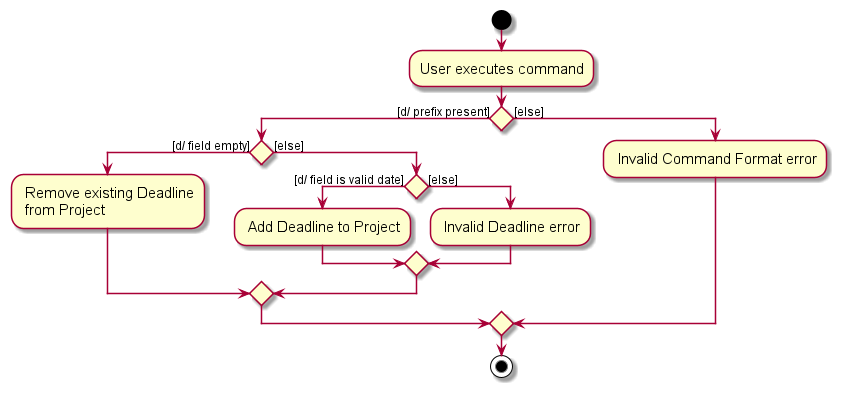
Add Task Feature
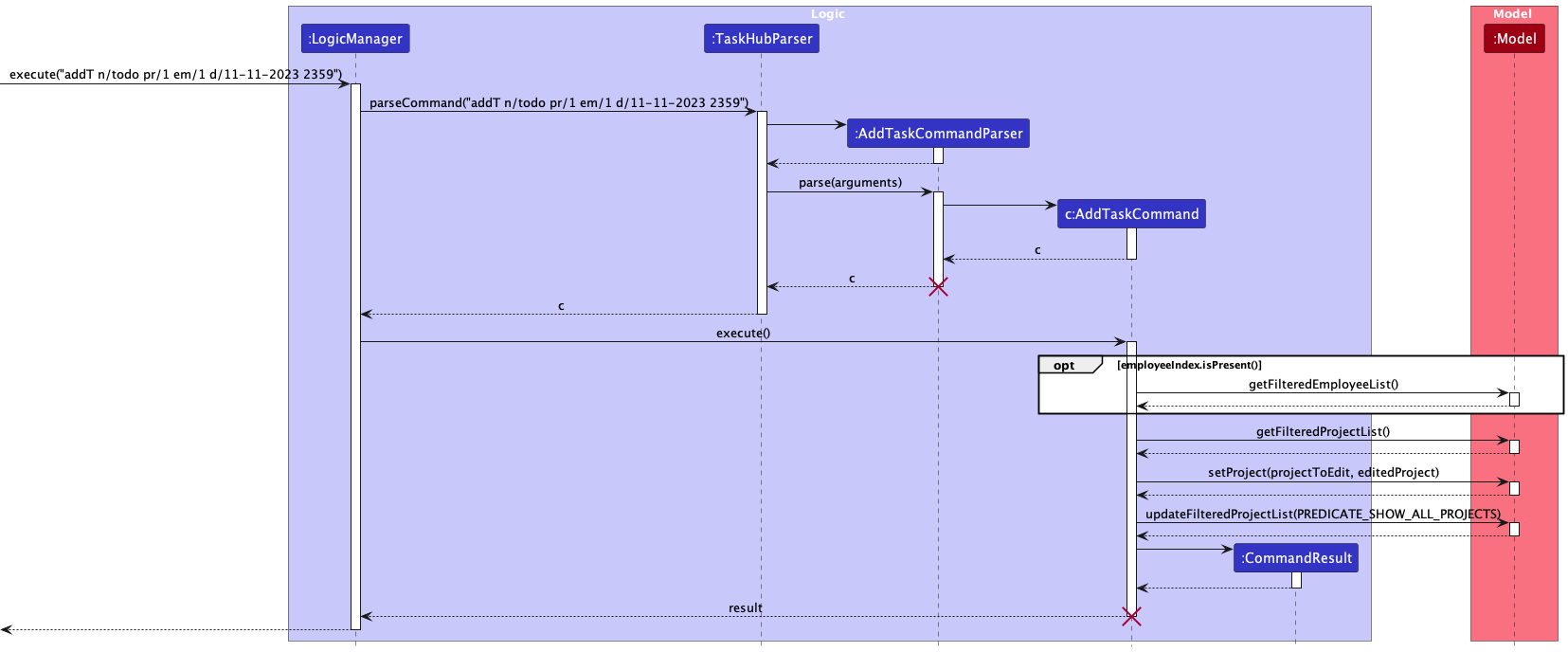
When creating a new task using the addT command, the TaskList of the specified Project is updated, and the Project is hence updated too.
Given below is an example usage scenario and the internal changes that happen at each step.
Step 1. The user launches the application. All employees and projects will be shown to the user.
Step 2. The user executes addT n/todo pr/1 em/1 d/11-11-2023 2359 to add a new Task called todo to the first currently listed Project, assigned to the first Employee within that Project. LogicManager will call TaskHubParser#parse(input) to extract the parameters and pass it to an AddTaskCommandParser.
Step 3. TaskHubParser will call AddTaskCommandParser#parse(arguments) to produce a AddTaskCommand to be executed by the LogicManager.
Step 4. LogicManager calls AddTaskCommand#execute(model) to produce a CommandResult to be logged.
Step 5. During the execution of the AddTaskCommand, a new Project copy is created, with an updated TaskList that contains the newly created Task.
If an employeeIndex was specified by the command (in this case it was), then Model::getFilteredEmployeeList is called to assign the new Task to the specified Employee.
Then, the Model#setProject and Model#updateFilteredProjectList is called, to trigger a Ui update, as the specified Project has been updated with an updated TaskList.
Step 6. A CommandResult is produced based on whether the execution was a success or not and returned to the LogicManager.
Storage Validation
When TaskHub is first loaded, the taskhub.json file is checked whether it can be converted into a valid TaskHub model.
This is to prevent undefined behaviour from users making modifications to the taskhub.json file.
Given below is an example usage scenario and the internal changes that happen at each step.
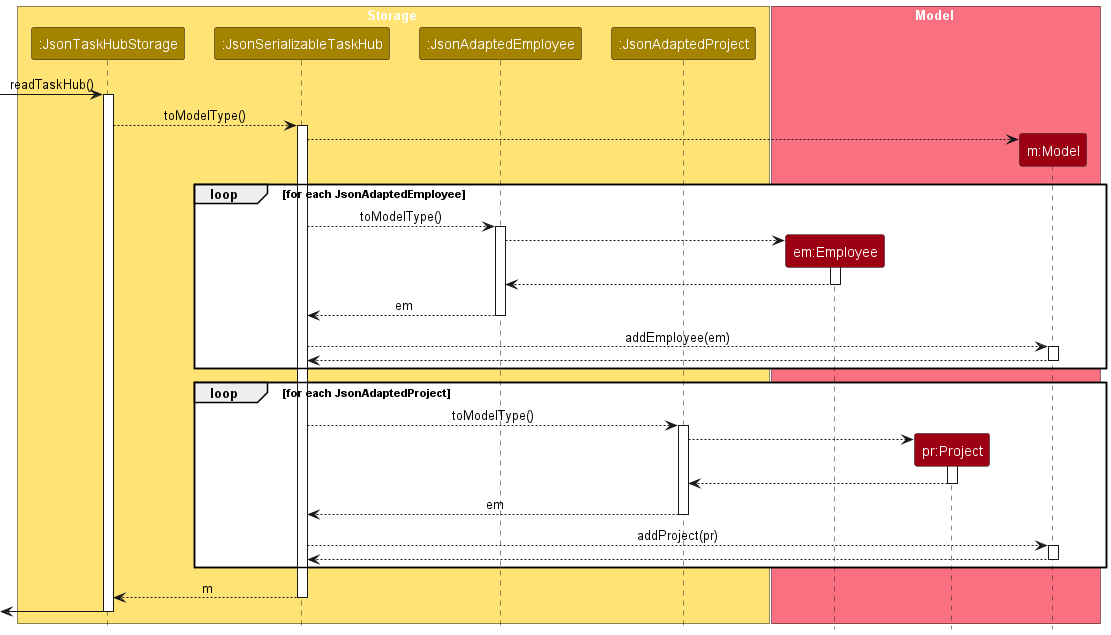
Step 1. The user launches the application.
Step 2. Main will look for the data file in the specified filepath in the preferences.json file and pass it to the JsonTaskHubStorage. If there is no file found,
then a new TaskHub with sample data will be created.
Step 3. After retrieving the data file, JsonTaskHubStorage will call JsonSerializableTaskHub to check whether each JsonAdaptedEmployee fulfills the requirements of an Employee.
If the requirements are fulfilled (Employee Requirements here), then each JsonAdaptedEmployee is converted into an Employee and added to a UniqueEmployeeList.
Step 4. JsonSerializableTaskHub will then check whether each JsonAdaptedProject fulfills the requirements of a Project.
If the requirements are fulfilled (Project Requirements here), then each JsonAdaptedProject is converted into a Project and added to a UniqueProjectList.
If any JsonAdaptedEmployee or JsonAdaptedProject fails to meet the requirements, an empty Taskhub is returned.
Documentation, logging, testing, configuration, dev-ops
Appendix: Requirements
Product scope
Target user profile:
- has a need to manage a significant number of employees in a project management context
- has a need to manage projects with multiple timelines
- has a need to quickly delegate and manage distribution of tasks and projects among employees
- prefer desktop apps over other types
- can type fast
- prefers typing to mouse interactions
- is reasonably comfortable using CLI apps
Value proposition: manage projects and task delegation faster than a typical mouse/GUI driven app
User stories
Priorities: High (must have) - * * *, Medium (nice to have) - * *, Low (unlikely to have) - *
| Priority | As a … | I want to … | So that I can… |
|---|---|---|---|
* * * |
completely new user | see usage instructions | refer to instructions when I forget how to use the App |
* * * |
user | add a new employee | easily manage and access employees in one place |
* * * |
user | delete an employee | remove entries that I no longer need |
* * * |
user | edit an employee | change the details of the employee |
* * * |
user | list all employees | see an overview of all the employees |
* * * |
user | add a new project | easily manage and access projects in one place |
* * * |
user | delete a project | remove entries that I no longer need |
* * * |
user | edit a project | change the details of the project |
* * * |
user | list all projects | see an overview of all my projects |
* * * |
user | find an employee by name | locate details of employees without having to go through the entire list |
* * * |
user | assign employees to a project | know which employees are on which projects in one place |
* * * |
user with projects | add a task to a project | know what needs to be done within a project |
* * * |
user with projects | delete a task from a project | remove accidental additions or remove tasks that are no longer needed |
* * * |
user with projects and employees | assign employees to a task | delegate tasks to them for efficient work allocation |
* * * |
user with tasks | mark a task as complete | keep track of my project’s progress based on the tasks that are completed |
* * * |
user with tasks | mark a task as incomplete | fix tasks that might have been marked as done but have more to be done |
* * * |
user with projects and tasks | sort tasks | see at a glance which tasks are done or which are most urgent and not yet done |
* * |
completely new user | have sample data | practice some commands before trying the App |
* * |
user | purge all data | get rid of sample/experimental data and add in my actual data |
* |
user with many projects in TaskHub | sort projects by date | tell which project deadlines are coming soon |
* |
user with many employees in TaskHub | sort employees by name | locate an employee easily |
* |
new user | get autocomplete suggestions | write commands without referring to usage instructions often |
Use cases
(For all use cases below, the System is the TaskHub and the Actor is the user, unless specified otherwise)
Use case: UC01 - Add an employee
MSS
- User requests to add an employee.
- TaskHub adds the employee to the list of employees and displays the updated list.
-
TaskHub shows that the employee has been added successfully.
Use case ends.
Extensions
- 1a. User enters an invalid command.
-
1a1. TaskHub shows an error message.
Use case ends.
-
- 1b. User does not enter a required field.
-
1b1. TaskHub shows an error message.
Use case ends.
-
- 1c. User enters details of an employee that already exists.
-
1c1. TaskHub shows an error message.
Use case ends.
-
- 1d. User enters an invalid value for a field.
-
1d1. TaskHub shows an error message.
Use case ends.
-
- 1e. User enters multiple values for a single-valued field.
-
1e1. TaskHub shows an error message.
Use case ends.
-
Use case: UC02 - Edit an employee
MSS
- User requests to edit the details of the employee.
- TaskHub edits the employee with the new details and displays the updated list.
-
TaskHub shows that the employee has been edited successfully.
Use case ends.
Extensions
- 1a. User enters an invalid command.
-
1a1. TaskHub shows an error message.
Use case ends.
-
- 1b. User does not enter at least one field to edit.
-
1b1. TaskHub shows an error message.
Use case ends.
-
- 1c. User enters an invalid value for a field.
-
1c1. TaskHub shows an error message.
Use case ends.
-
- 1d. User edits the employee’s name to one that already exists.
-
1d1. TaskHub shows an error message.
Use case ends.
-
- 1e. User enters multiple values for a single-valued field.
-
1e1. TaskHub shows an error message.
Use case ends.
-
Use case: UC03 - Delete an employee
MSS
- User requests to delete an employee.
- TaskHub deletes the employee from the list of employees and displays the updated list.
-
TaskHub shows that the employee has been deleted successfully.
Use case ends.
Extensions
- 1a. User enters an invalid command.
-
1a1. TaskHub shows an error message.
Use case ends.
-
- 1b. User does not enter a valid index for the employee.
-
1b1. TaskHub shows an error message.
Use case ends.
-
Use case: UC04 - List all employees
MSS
- User requests to list all employees.
- TaskHub displays the list of employees.
-
TaskHub shows that all employees have been listed successfully.
Use case ends.
Extensions
- 1a. User enters an invalid command.
-
1a1. TaskHub shows an error message.
Use case ends.
-
Use case: UC05 - Find an employee by name
MSS
- User lists all employees (UC04).
- User requests to find the employee by name.
- TaskHub displays the list of employees with the name.
- TaskHub displays the relevant list of projects in which the shown employees are involved in.
-
TaskHub shows a success message to the User.
Use case ends.
Extensions
- 2a. User enters an invalid command.
-
2a1. TaskHub shows an error message.
Use case ends.
-
- 2b. User does not enter a name.
-
2b1. TaskHub shows an error message.
Use case ends.
-
- 2c. User enters a name that does not exist.
-
2c1. TaskHub shows a blank list of employees and projects.
Use case ends.
-
Use case: UC06 - Add a project
MSS
- User requests to add a project.
- TaskHub adds the project to the list of projects and displays the updated list.
-
TaskHub shows that the project has been added successfully.
Use case ends.
Extensions
- 1a. User enters an invalid command.
-
1a1. TaskHub shows an error message.
Use case ends.
-
- 1b. User does not enter a required field.
-
1b1. TaskHub shows an error message.
Use case ends.
-
- 1c. User enters details of a project that already exists.
-
1c1. TaskHub shows an error message.
Use case ends.
-
- 1d. User enters an invalid value for a field.
-
1d1. TaskHub shows an error message.
Use case ends.
-
- 1e. User enters multiple values for a single-valued field.
-
1e1. TaskHub shows an error message.
Use case ends.
-
Use case: UC07 - List all projects
MSS
- User requests to list all projects.
- TaskHub displays the list of projects.
-
TaskHub shows that all projects have been listed successfully.
Use case ends.
Extensions
- 1a. User enters an invalid command.
-
1a1. TaskHub shows an error message.
Use case ends.
-
Use case: UC08 - Edit a project
MSS
- User lists all projects (UC07).
- User requests to edit the details of a project.
- TaskHub edits the project with the new details and displays the updated list.
-
TaskHub shows that the project has been edited successfully.
Use case ends.
Extensions
- 2a. User enters an invalid command.
-
2a1. TaskHub shows an error message.
Use case ends.
-
- 2b. User does not enter a valid index for the project.
-
2b1. TaskHub shows an error message.
Use case ends.
-
- 2c. User does not enter at least one field to edit.
-
2c1. TaskHub shows an error message.
Use case ends.
-
- 2d. User enters an invalid value for a field.
-
2d1. TaskHub shows an error message.
Use case ends.
-
- 2e. User edits the project’s name to one that already exists.
-
2e1. TaskHub shows an error message.
Use case ends.
-
- 2f. User enters multiple values for a single-valued field.
-
2f1. TaskHub shows an error message.
Use case ends.
-
Use case: UC09 - Delete a project
MSS
- User lists all projects (UC07).
- User requests to delete a project.
- TaskHub deletes the project from the list of projects and displays the updated list.
-
TaskHub shows that the project has been deleted successfully.
Use case ends.
Extensions
- 2a. User enters an invalid command.
-
2a1. TaskHub shows an error message.
Use case ends.
-
- 2b. User does not enter a valid index for the project.
-
2b1. TaskHub shows an error message.
Use case ends.
-
Use case: UC10 - Find a project by name
MSS
- User requests to find a project by name.
- TaskHub displays the list of projects with the name.
-
TaskHub displays the relevant list of employees where the shown projects involve those employees.
Use case ends.
Extensions
- 1a. User enters an invalid command.
-
1a1. TaskHub shows an error message.
Use case ends.
-
- 1b. User does not enter a name.
-
1b1. TaskHub shows an error message.
Use case ends.
-
- 1c. User enters a name that does not exist.
-
1c1. TaskHub shows a blank list of projects and employees.
Use case ends.
-
Use case: UC11 - Mark a project as completed
MSS
- User lists all projects (UC07).
- User requests to mark a project as completed.
- TaskHub marks the project as completed and displays the updated list.
-
TaskHub shows that the project has been marked as completed successfully.
Use case ends.
Extensions
- 2a. User enters an invalid command.
-
2a1. TaskHub shows an error message.
Use case ends.
-
- 2b. User does not enter a valid index for the project.
-
2b1. TaskHub shows an error message.
Use case ends.
-
- 2c. User enters a project that is already completed.
-
2c1. TaskHub shows that the project has been marked as completed successfully.
Use case ends.
-
Use case: UC12 - Mark a project as incomplete
MSS
- User lists all projects (UC07).
- User requests to mark a project as incomplete.
- TaskHub marks the project as incomplete and displays the updated list.
-
TaskHub shows that the project has been marked as incomplete successfully.
Use case ends.
Extensions
- 2a. User enters an invalid command.
-
2a1. TaskHub shows an error message.
Use case ends.
-
- 2b. User does not enter a valid index for the project.
-
2b1. TaskHub shows an error message.
Use case ends.
-
- 2c. User enters a project that is already incomplete.
-
2c1. TaskHub shows that the project has been marked as incomplete successfully.
Use case ends.
-
Use case: UC13 - Edit deadlines of multiple projects
This use case is also applicable to editing priority of multiple projects.
MSS
- User lists all projects (UC07).
- User requests to edit the deadlines of multiple projects.
- TaskHub edits the deadlines of the projects with the new details and displays the updated list.
-
TaskHub shows that the deadlines of the projects have been edited successfully.
Use case ends.
Extensions
- 2a. User enters an invalid command.
-
2a1. TaskHub shows an error message.
Use case ends.
-
- 2b. User does not enter at least one field to edit.
-
2b1. TaskHub shows an error message.
Use case ends.
-
- 2c. User enters an invalid value for a field.
-
2c1. TaskHub shows an error message.
Use case ends.
-
- 2d. User enters multiple values for a single-valued field.
-
2d1. TaskHub shows an error message.
Use case ends.
-
Use case: UC14 - Add a new task to a project
MSS
- User lists all projects (UC07).
- User requests to add a new task to a project.
- TaskHub adds the new task to the project and displays the updated list of tasks in the project.
-
TaskHub shows that the task has been added successfully.
Use case ends.
Extensions
- 2a. User enters an invalid command.
-
2a1. TaskHub shows an error message.
Use case ends.
-
- 2b. User does not enter a required field.
-
2b1. TaskHub shows an error message.
Use case ends.
-
- 2c. User enters an invalid value for a field.
-
2c1. TaskHub shows an error message.
Use case ends.
-
- 2d. User enters multiple values for a field.
-
2d1. TaskHub shows an error message.
Use case ends.
-
Use case: UC15 - Delete a task from a project
MSS
- User lists all projects (UC07).
- User requests to delete a task from a project.
- TaskHub deletes the task from the project and displays the updated list of tasks in the project.
-
TaskHub shows that the task has been deleted successfully.
Use case ends.
Extensions
- 2a. User enters an invalid command.
-
2a1. TaskHub shows an error message.
Use case ends.
-
- 2b. User does not enter a required field.
-
2b1. TaskHub shows an error message.
Use case ends.
-
- 2c. User enters an invalid value for a field.
-
2c1. TaskHub shows an error message.
Use case ends.
-
- 2d. User enters multiple values for a single-valued field.
-
2d1. TaskHub shows an error message.
Use case ends.
-
Use case: UC16 - Mark a task as completed
MSS
- User lists all projects (UC07).
- User requests to mark a task as completed.
- TaskHub marks the task as completed and displays the updated list of tasks in the project.
-
TaskHub shows that the task has been marked as completed successfully.
Use case ends.
Extensions
- 2a. User enters an invalid command.
-
2a1. TaskHub shows an error message.
Use case ends.
-
- 2b. User does not enter a required field.
-
2b1. TaskHub shows an error message.
Use case ends.
-
- 2c. User enters an invalid value for a field.
-
2c1. TaskHub shows an error message.
Use case ends.
-
- 2d. User enters multiple values for a single-valued field.
-
2d1. TaskHub shows an error message.
Use case ends.
-
- 2e. User enters a task that is already completed.
-
2e1. TaskHub shows that the task has been marked as completed successfully.
Use case ends.
-
Use case: UC17 - Mark a task as incomplete
MSS
- User lists all projects (UC07).
- User requests to mark a task as incomplete.
- TaskHub marks the task as incomplete and displays the updated list of tasks in the project.
-
TaskHub shows that the task has been marked as incomplete successfully.
Use case ends.
Extensions
- 2a. User enters an invalid command.
-
2a1. TaskHub shows an error message.
Use case ends.
-
- 2b. User does not enter a required field.
-
2b1. TaskHub shows an error message.
Use case ends.
-
- 2c. User enters an invalid value for a field.
-
2c1. TaskHub shows an error message.
Use case ends.
-
- 2d. User enters multiple values for a single-valued field.
-
2d1. TaskHub shows an error message.
Use case ends.
-
- 2e. User enters a task that is already incomplete.
-
2e1. TaskHub shows that the task has been marked as incomplete successfully.
Use case ends.
-
Use case: UC18 - Sort tasks in a project
MSS
- User lists all projects (UC07).
- User finds a project (UC10).
- User requests to sort the tasks in the project.
- TaskHub sorts the tasks in the project by deadline and completion status, and displays the updated list of tasks in the project.
-
TaskHub shows that the tasks have been sorted successfully.
Use case ends.
Extensions
- 2a. User enters an invalid command.
-
2a1. TaskHub shows an error message.
Use case ends.
-
- 2b. There are no tasks to sort.
-
2b1. TaskHub shows success message but there is no effect on the project.
Use case ends.
-
Use case: UC19 - List all employees and projects
MSS
- User requests to list all employees and projects.
- TaskHub lists all employees and projects.
-
TaskHub shows that all employees and projects have been listed successfully.
Use case ends.
Extensions
- 1a. User enters an invalid command.
-
1a1. TaskHub shows an error message.
Use case ends.
-
Use case: UC20 - Assign an employee to a project
MSS
- User lists all employees and projects (UC19).
- User requests to assign an employee to a project.
- TaskHub assigns the employee to the project and displays the updated list of employees and projects.
-
TaskHub shows that the employee has been assigned to the project successfully.
Use case ends.
Extensions
- 2a. User enters an invalid command.
-
2a1. TaskHub shows an error message.
Use case ends.
-
- 2b. User does not enter a required field.
-
2b1. TaskHub shows an error message.
Use case ends.
-
- 2c. User enters an invalid value for a field.
-
2c1. TaskHub shows an error message.
Use case ends.
-
- 2d. User enters multiple values for a single-valued field.
-
2d1. TaskHub shows an error message.
Use case ends.
-
- 2e. User enters an employee that is already assigned to the project.
-
2e1. TaskHub shows success message but there is no effect on the project.
Use case ends.
-
Use case: UC21 - Un-assign an employee from a project
MSS
- User lists all employees and projects (UC19).
- User requests to un-assign an employee from a project.
- TaskHub un-assigns the employee from the project and displays the updated list of employees and projects.
-
TaskHub shows that the employee has been un-assigned from the project successfully.
Use case ends.
Extensions
- 2a. User enters an invalid command.
-
2a1. TaskHub shows an error message.
Use case ends.
-
- 2b. User does not enter a required field.
-
2b1. TaskHub shows an error message.
Use case ends.
-
- 2c. User enters an invalid value for a field.
-
2c1. TaskHub shows an error message.
Use case ends.
-
- 2d. User enters multiple values for a single-valued field.
-
2d1. TaskHub shows an error message.
Use case ends.
-
- 2e. User enters an employee that is not assigned to the project.
-
2e1. TaskHub shows an error message.
Use case ends.
-
Use case: UC22 - Assign an employee to a task in a project
MSS
- User lists all employees and projects (UC19).
- User requests to assign an employee to a task in a project.
- TaskHub assigns the employee to the task in the project and displays the updated list of employees and projects.
-
TaskHub shows that the employee has been assigned to the task in the project successfully.
Use case ends.
Extensions
- 2a. User enters an invalid command.
-
2a1. TaskHub shows an error message.
Use case ends.
-
- 2b. User does not enter a required field.
-
2b1. TaskHub shows an error message.
Use case ends.
-
- 2c. User enters an invalid value for a field.
-
2c1. TaskHub shows an error message.
Use case ends.
-
- 2d. User enters multiple values for a field.
-
2d1. TaskHub shows an error message.
Use case ends.
-
- 2e. User enters an employee that is already assigned to the task in the project.
-
2e1. There is no change to the project or task.
Use case resumes from step 4.
-
- 2f. User enters a task that is already assigned to another employee in the project.
-
2f1. TaskHub replaces the existing employee in the task with the new employee.
Use case resumes from step 4.
-
Use case: UC23 - Un-assign an employee from a task in a project
MSS
- User lists all employees and projects (UC19).
- User requests to un-assign an employee from a task in a project.
- TaskHub un-assigns the employee from the task in the project and displays the updated list of employees and projects.
-
TaskHub shows that the employee has been un-assigned from the task in the project successfully.
Use case ends.
Extensions
- 2a. User enters an invalid command.
-
2a1. TaskHub shows an error message.
Use case ends.
-
- 2b. User does not enter a required field.
-
2b1. TaskHub shows an error message.
Use case ends.
-
- 2c. User enters an invalid value for a field.
-
2c1. TaskHub shows an error message.
Use case ends.
-
- 2d. User enters multiple values for a field.
-
2d1. TaskHub shows an error message.
Use case ends.
-
- 2e. User enters a task that is not assigned to any employee.
-
2e1. TaskHub shows an error message.
Use case ends.
-
Use case: UC24 - Clear all data
MSS
- User requests to clear all data.
- TaskHub clears all data and displays an empty list of employees and projects.
-
TaskHub shows that all data has been cleared successfully.
Use case ends.
Use case: UC25 - Exit the application
MSS
- User requests to exit the application.
-
TaskHub exits and closes.
Use case ends.
Extensions
- 1a. User enters an invalid command.
-
1a1. TaskHub shows an error message.
Use case ends.
-
Non-Functional Requirements
- Should work on any mainstream OS as long as it has Java
11or above installed. - Should be able to hold up to 1000 employees without a noticeable(More than 2s) sluggishness in performance for typical usage.
- A user with above average typing speed for regular English text (i.e. not code, not system admin commands) should be able to accomplish most of the tasks faster using commands than using the mouse.
- Should continue to work in most file directories as long as TaskHub and its data file maintain the same structure.
- Should be easily usable even by a first time user.
Glossary
- Mainstream OS: Windows, Linux, Unix, macOS
Requirements yet to be implemented
- Sorting projects by completion and date has not yet been implemented.
- Sorting employees by name has not yet been implemented.
- Autocomplete commands has not yet been implemented.
- Assigning multiple employees to a task has not yet been implemented.
Appendix: Instructions for manual testing
Given below are instructions to test the app manually.
If there are no prerequisites stated, all you have to do is just open TaskHub and you can use the sample data.
You can reset the sample data by deleting taskhub.json in the data folder and relaunching TaskHub.
The testcases should also be done separately and not in sequence, i.e. The results of a testcase may affect the next testcase if the changes are not reversed.
Launch and shutdown
-
Initial launch
-
Download the jar file and copy into an empty folder.
-
Launch TaskHub by running the jar file in your terminal.
Expected: Shows the GUI with a set of sample contacts. The window size may not be optimum.
-
-
Saving window preferences
-
Resize the window to an optimum size. Move the window to a different location. Close the window.
-
Re-launch TaskHub by running the jar file in your terminal.
Expected: The most recent window size and location is retained.
-
-
GUI Shutdown
- While in TaskHub, click on the
Filebutton in the menu bar and clickExit.
Expected: The TaskHub window is closed.
- While in TaskHub, click on the
-
CLI Shutdown
- Enter
exitin the command bar and press enter.
Expected: The TaskHub window is closed.
- Enter
Viewing Help
-
GUI Help
- While in TaskHub, click on the
Helpbutton in the menu bar and clickHelp.
Expected: The TaskHub Help window is opened.
- While in TaskHub, click on the
-
CLI Help
- Enter
helpin the command bar and press enter.
Expected: The TaskHub Help window is opened.
- Enter
-
F1Help- While in TaskHub, press
F1on your keyboard.
Expected: The TaskHub Help window is opened.
- While in TaskHub, press
Listing all employees and projects
-
List both employees and projects
-
Test Case:
list
Expected: Both employees and projects are listed in full, with its corresponding message shown to the user. -
Test Case:
list extra keywords
Expected: Same as previous
-
Clearing all entries
-
Clear all stored data in TaskHub
-
Test Case:
clear
Expected: All employees and projects are deleted, with its corresponding message shown to the user. -
Test Case:
clear extra keywords
Expected: Same as previous
-
Adding an employee
-
Add a new employee
-
Test Case:
addE n/John Doe p/98765432 e/johnd@example.com a/John street, block 123, #01-01 t/Employee t/Junior
Expected: Employee “John Doe”, with phone number “98765432”, email “johnd@example.com”, living at “John street, block 123, #01-01”, with tags “Employee” and “Junior” is added to TaskHub. -
Test Case:
addE n/John Doe p/98765432 e/johnd@example.com a/John street, block 123, #01-01
Expected: Same as previous but with no tags. -
Test Case:
addE p/98765432 e/johnd@example.com a/John street, block 123, #01-01
Expected: No employee is added and an error message indicating “Invalid Command Format” is returned. -
Test Case:
addE n/John Doe n/John Doe p/98765432 e/johnd@example.com a/John street, block 123, #01-01
Expected: No employee is added and an error message indicating duplicate fields are being used is returned. -
Test Case:
addE [Employee with same name as previously added employee]
Expected: No employee is added and an error message indicating that the employee already exists in TaskHub is returned.
-
Editing an employee
-
Edit an employee
-
Prerequisite: There mst be employees present in the displayed employee list.
-
Test Case:
editE 1 p/91234567 e/johndoe@example.com
Expected: Edits the phone number and email address of the 1st employee to be 91234567 and johndoe@example.com respectively. -
Test Case:
editE 2 t/
Expected: Removes all existing tags of the 2nd employee. -
Test Case:
editE 1
Expected: No employees edited and an error message indicating that at least one of the fields to edit must be provided is returned.
-
Deleting an employee
-
Delete an employee
-
Prerequisite: There mst be employees present in the displayed employee list.
-
Test case:
deleteE 1
Expected: First employee is deleted from the list. Details of the deleted employee shown in the message. -
Test case:
deleteE 0
Expected: No employee is deleted and an error message indicating the index provided was not a positive non-zero integer is returned. -
Other incorrect delete commands to try:
deleteE,deleteE x,deleteE 1 2 3,...(where x is larger than the employee list size)
Expected: Similar to previous but with different error messages.
-
Listing all employees
-
Listing all the employees(only)
-
Prerequisite: Run
findP marketto filter the employees to be only those in theMarket Expansionproject, and the projects to only be the same project. -
Test case:
listE
Expected: Only the employees list should be updated to display all the employees, together with its corresponding message shown to the user. -
Test case:
listE extra keywords
Expected: Similar to previous.
-
Locate employees by name
-
Finding an employee
-
Prerequisite: There must be employees present in TaskHub.
-
Test case:
findE alex yu
Expected: Employees whose name has “alex” or “yu” are listed. In the case of the sample data, it should only be “Alex Yeoh” and “Bernice Yu”. -
Test case:
findE ALEX YU
Expected: Same as previous. -
Test case:
findE al
Expected: Employees whose name has “al” are listed. In the case of the sample data, no employee has a name where any part is made up of “al” only, hence there should be 0 employees listed. -
Test case:
findE
Expected: No employees will be searched for and an error message indicating “Invalid Command Format” is returned.
-
Adding a new project
-
Add a project
-
Test Case:
addP n/Project1 em/1 2 3
Expected: Project with name “Project1”, is created and employees indexed at 1, 2, and 3 are assigned to it. -
Test Case:
addP n/Project1
Expected: Same as previous but with no employees assigned. -
Test Case:
addP em/1 2 3
Expected: No project is created and an error message indicating “Invalid Command Format” is returned. -
Test Case:
addP n/Project1 n/Project1 em/1 2 3
Expected: No project is created and an error message indicating duplicate fields are being used is returned. -
Test Case:
addE [Project with same name as previously added project]
Expected: No project is added and an error message indicating that the project already exists in TaskHub is returned.
-
Editing a project
-
Edit a project
-
Prerequisite: There must be projects present in the displayed project list.
-
Test Case:
editP 1 n/Market Analysis p/low d/10-10-2023
Expected: Edits the name, priority, and deadline of the 1st project to be “Market Analysis”, low priority, and 10-10-2023, respectively. -
Test Case:
editP 1
Expected: No projects edited and an error message indicating that at least one of the fields to edit must be provided is returned.
-
Deleting a project
-
Delete a project
-
Prerequisite: There must be projects present in the displayed project list.
-
Test case:
deleteP 1
Expected: First project is deleted from the list. Details of the deleted project are shown in the message. -
Test case:
deleteP 0
Expected: No project is deleted and an error message indicating the index provided was not a positive non-zero integer is returned. -
Other incorrect delete commands to try:
deleteP,deleteP x,deleteP 1 2 3,...(where x is larger than the project list size)
Expected: Similar to previous but with different error messages.
-
Marking project(s) as completed
-
Mark projects as complete
-
Prerequisite: There must be projects present in the displayed project list.
-
Test case:
markP 1 2 3
Expected: Marks projects at indexes 1, 2, 3 as completed and returns the corresponding message to the user. -
Test case:
markP 0
Expected: No project is marked and an error message indicating the index provided was not a positive non-zero integer is returned.
-
Marking project(s) as incomplete
-
Mark project(s) as incomplete
-
Prerequisite: There must be projects present in the displayed project list.
-
Test case:
unmarkP 1 2 3
Expected: Marks projects at indexes 1, 2, 3 as incomplete and returns the corresponding message to the user. -
Test case:
unmarkP 0
Expected: No project is marked as incomplete and an error message indicating the index provided was not a positive non-zero integer is returned.
-
Editing deadline of project(s)
-
Edit the deadline of project(s)
-
Prerequisite: There must be projects present in the displayed project list.
-
Test case:
dlP 1 2 3 d/10-10-2023
Expected: Sets the deadline of the projects indexed at 1, 2, and 3 as 10-10-2023 and returns the corresponding message to the user. -
Test case:
dlP 1 2 3 d/
Expected: Removes the deadline of the projects indexed at 1, 2, and 3 and returns the corresponding message to the user. -
Test case:
dlP 1 d/10-13-2023
Expected: No deadline in any project is edited and the correct way to format the date is returned as an error message. -
Test case:
dlP 0 d/
Expected: No deadline in any project is edited and an error message indicating the index provided was not a positive non-zero integer is returned.
-
Prioritising projects
-
Prioritise projects
-
Prerequisite: There must be projects present in the displayed project list.
-
Test case:
priorityP 1 2 3 p/high
Expected: The priority of the projects indexed at 1, 2, and 3 are set to high, with its corresponding message shown to the user. -
Test case:
priorityP 1 2 3 p/important
Expected: No projects have their priorities changed, and an error message indicating that the priority should only be low, normal, or high, is returned. -
Test case:
priorityP 1
Expected: No projects have their priorities changed and an error message indicating “Invalid Command Format” is returned. -
Test case:
priorityP 0 p/low
Expected: No projects have their priorities changed and an error message indicating the index provided was not a positive non-zero integer is returned.
-
Listing all projects
-
List all the projects(only)
-
Prerequisite: Run
findE alexto filter the employees list to be only those with the namealex, and the projects list to the projects that those employees are assigned to. -
Test case:
listP
Expected: Only the projects list should be updated to display all the projects, together with its corresponding message returned to the user. -
Test case:
listP extra keywords
Expected: Similar to previous.
-
Locating projects by name
-
Find a project
-
Prerequisite: There must be projects present in the displayed project list.
-
Test case:
findP market product
Expected: Projects whose name has “market” or “product” are listed. In the case of the sample data, it should only be “Market Expansion” and “New Product Launch” projects. -
Test case:
findP MARKET PRODUCT
Expected: Same as previous. -
Test case:
findP mark
Expected: Projects whose name has “mark” are listed. In the case of the sample data, no project has a name where any part is made up of “mark” only, hence there should be 0 projects listed. -
Test case:
findP
Expected: No projects will be searched for and an error message indicating “Invalid Command Format” is returned.
-
Adding a new task to a project
-
Add a task
-
Prerequisite: There must be projects present in the displayed project list and if you want to simultaneously assign an employee to the task, they must also be assigned to the project.
-
Test case:
addT pr/1 em/1 n/Website d/11-10-2023 2359
Expected: A task named “Website” is added to the first project, with deadline “11-10-2023 11:59PM”, and the employee indexed at 1 in the employee list is assigned to it. The corresponding message is also returned to the user. -
Test case:
addT pr/1 n/Website d/11-10-2023 2359
Expected: Same as previous but without the employee assigned. -
Test case:
addT n/Website d/11-10-2023 2359
Expected: No tasks will be added and an error message indicating “Invalid Command Format” is returned.
-
Deleting a task from a project
-
Delete tasks
-
Prerequisite: There must be projects which contain tasks present in the displayed project list.
-
Test case:
deleteT pr/1 t/1 3
Expected: Tasks indexed at 1 and 3 in the task list of the first project in the project list are deleted from that project and the corresponding message is returned to the user. -
Other incorrect delete commands to try:
deleteT,deleteT pr/1 t/x,deleteT pr/x t/1,deleteP 1 2 3,...(where x is larger than the project list or task list size)
Expected: Similar to previous but with different error messages.
-
Marking task(s) as complete
-
Mark tasks as complete
-
Prerequisite: There must be projects which contain tasks present in the displayed project list.
-
Test case:
markT pr/1 t/1 2 3
Expected: Marks tasks at indexes 1, 2, 3 in the first project as completed and returns the corresponding message to the user. -
Test case:
markT pr/1 t/0
Expected: No tasks are marked and an error message indicating the index provided was not a positive non-zero integer is returned.
-
Marking task(s) as incomplete
-
Mark tasks as incomplete
-
Prerequisite: There must be projects which contain tasks present in the displayed project list.
-
Test case:
unmarkT pr/1 t/1 2 3
Expected: Marks tasks at indexes 1, 2, 3 in the first project as incomplete and returns the corresponding message to the user. -
Test case:
unmarkT pr/1 t/0
Expected: No tasks are marked as incomplete and an error message indicating the index provided was not a positive non-zero integer is returned.
-
Sort tasks
-
Sort tasks according to deadline and completion status
-
Prerequisite: There must be projects with tasks in the displayed project list.
-
Test case:
sortT
Expected: Tasks in all projects in the displayed project list are sorted, incomplete tasks are placed first, with those with earlier deadlines being placed first. The corresponding message is also returned to the user. -
Test case:
sortT extra keywords
Expected: Same as previous.
-
Assign employee(s) to a project
-
Assign employees to a project
-
Prerequisite: There must be employees and project present in the displayed employee and project list.
-
Test case:
assignP pr/2 em/1 3
Expected: Employees at indexes at 1 and 3 in the employee list are assigned to the second project and the corresponding message is returned to the user. -
Test case:
assignP em/1 3
Expected: No employees will be assigned to any project and an error message indicating “Invalid Command Format” is returned.
-
Un-assign employee(s) from a project
-
Unassign employees from a project
-
Prerequisite: There must be employees and projects in the displayed employee and project list with employees assigned present to the projects.
-
Test case:
unassignP pr/2 em/1 3
Expected: Employees at indexes at 1 and 3 in the employee list are unassigned from the second project if they were assigned originally, and the corresponding message is returned to the user. -
Test case:
unassignP em/1 3
Expected: No employees will be unassigned from any project and an error message indicating “Invalid Command Format” is returned.
-
Assign an employee to a task
-
Assign employee in a project to a task
-
Prerequisite: There must be a project in the displayed project list containing at least an employee and a task.
-
Test case:
assignT pr/2 em/1 t/1
Expected: Employee at index 1 in the second project is assigned to the first task and the corresponding message is returned to the user. -
Test case:
assignT em/1 t/1
Expected: No employees will be assigned to any task in the project and an error message indicating “Invalid Command Format” is returned.
-
Un-assign an employee from a task
-
Unassign employee in a project from a task
-
Prerequisite: There must be a project in the displayed project list containing an employee and a task with an assigned employee.
-
Test case:
unassignT pr/2 t/1
Expected: Un-assigns the first task in the second project from any employees currently assigned to it and returns the corresponding message to the user.
If there are no employees assigned to the task, an error messaged indicating no employees were assigned yet is returned to the user. -
Test case:
unassignT em/1 t/1
Expected: No employees will be un-assigned from any task in the project and an error message indicating “Invalid Command Format” is returned.
-
Saving data
-
Dealing with missing/corrupted data files
-
Prerequisite: Edit
taskhub.jsonand modify the stored values such that they do not tally.
e.g. The name of an employee in the employee list is different from the name of an employee in the project that the employee is assigned to. -
Launch TaskHub by running the
taskhub.jarthrough your terminal.
Expected: TaskHub launches but all the panels are empty.
-
Appendix: Planned Enhancements
Given below are the planned enhancements for the application.
- The current validation for duplicate employees is too strict as it does not allow employees with the same name, but different details, to exist in the employee list. We plan to add a unique ID field for each employee to allow employees with the same name and differing IDs to exist in the employee list.
- The current validation for emails is too lenient as it allows some invalid emails to be accepted as valid.
For example, in the following email format
local-part@domain, thelocal-partcan exceed the maximum length of 64 characters and is considered valid in our application, when it shouldn’t be. We plan to use a stricter regular expression to validate emails, which is mentioned here. - Currently, there is no validation to check if the project deadline is before the task deadline.
Therefore, users can add tasks with deadlines past the project deadline by accident without knowing.
We plan to add a warning to the user if the user tries to add a task with a deadline past the project deadline:
The newly added task has a deadline past the project deadline! Check again if the details are correct and edit if needed! - Currently, a maximum of only one employee can be assigned to each task, which does not accurately reflect the real world. We plan to allow multiple employees to be assigned to each task.
- Currently, commands that allow users to add multiple continuous indexes (e.g.
priorityP 1 2 3 p/low) do not allow multiple spaces between indexes (e.g.priorityP 1 2 3 p/low). Instead, an error message is currently shown to the user sayingIndex provided was not a non-zero unsigned integer. This is not valid: <empty>, due to the extra space. We plan to allow multiple spaces between indexes to be handled automatically instead of the user having to find where they may have put the additional space(s). - Employee names currently cannot contain special characters, as the validation for this is too strict.
A name such as
Vishnu S/O Prasathcannot be added to the employee list, even though it could be a valid name. We plan to allow some special characters, such as/and-, to be used in an employee’s name. - The
sortTcommand currently runs without displaying any error message, even if there are no tasks displayed in the project list. This does not affect the functionality of thesortTcommand. Nonetheless, we plan to add an error message to be displayed to the user sayingThere are no displayed projects containing any task!, thereby indicating that there are no displayed tasks to be sorted.
Appendix: Effort
Difficulty Level
Building TaskHub was of moderate to high difficulty for our team due to the following reasons:
- We had to build on top of an existing, brownfield project, the codebase of which we were not familiar with
- It was our first time working with Java and JavaFX in a software engineering context
- We created two more model components (
Projects andTasks) with dependencies among each other and withEmployees
Challenges Faced
We had encountered the following challenges during the process of building TaskHub:
- Refactoring the AB3 codebase to fit TaskHub’s requirements
- Although refactoring was not as difficult as creating new features, it did take a while due to the size of AB3’s codebase. Specifically, we refactored
Persons toEmployees, as well as the product name from AB3 to TaskHub.
- Although refactoring was not as difficult as creating new features, it did take a while due to the size of AB3’s codebase. Specifically, we refactored
- Morphing
Remarks intoProjects- In keeping with the evolutionary style of the tP, we decided to morph
Remarkfrom the Remark tutorial intoProject. This was especially challenging due to the vast differences between how both of them were structured/meant to behave.
- In keeping with the evolutionary style of the tP, we decided to morph
- Introducing
Tasks along with its dependencies- We felt that this was one of the most challenging parts of our project since this third entity introduced additional dependencies and opened our project up to more potential bugs. Implementing the user interface components for
Tasks was also not easy as they had to be made simple yet descriptive for the user.
- We felt that this was one of the most challenging parts of our project since this third entity introduced additional dependencies and opened our project up to more potential bugs. Implementing the user interface components for
Effort Required
Given the above difficulties and challenges, due to the two additional entities of Project and Task (on top of AB3’s Person) along with all of their attributes (e.g. Deadline, Priority and CompletionStatus), a considerable amount of effort was put in to manage the additional dependencies and conduct additonal unit/integration testing.
Achievements
- Built a comprehensive but easy-to-understand user interface for
Employees,Projects andTasks - Introduced new features that were previously not included in AB3, such as sorting tasks according to deadline and completion status